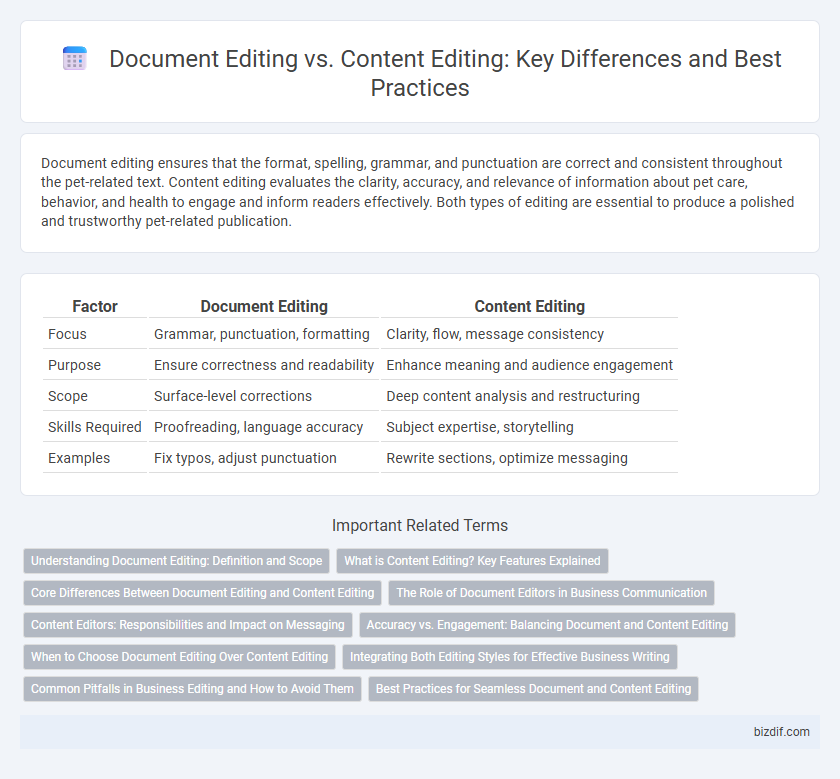Document editing ensures that the format, spelling, grammar, and punctuation are correct and consistent throughout the pet-related text. Content editing evaluates the clarity, accuracy, and relevance of information about pet care, behavior, and health to engage and inform readers effectively. Both types of editing are essential to produce a polished and trustworthy pet-related publication.
Table of Comparison
| Factor | Document Editing | Content Editing |
|---|---|---|
| Focus | Grammar, punctuation, formatting | Clarity, flow, message consistency |
| Purpose | Ensure correctness and readability | Enhance meaning and audience engagement |
| Scope | Surface-level corrections | Deep content analysis and restructuring |
| Skills Required | Proofreading, language accuracy | Subject expertise, storytelling |
| Examples | Fix typos, adjust punctuation | Rewrite sections, optimize messaging |
Understanding Document Editing: Definition and Scope
Document editing involves reviewing and correcting the overall structure, formatting, and clarity of a document to ensure consistency and coherence across sections. It encompasses grammar, punctuation, spelling, layout adjustments, and adherence to style guidelines to enhance readability and professional presentation. Unlike content editing, which focuses on the substance and flow of ideas, document editing targets the technical and visual accuracy essential for polished communication.
What is Content Editing? Key Features Explained
Content editing involves evaluating and improving the substance, structure, and clarity of a document to enhance its overall message and flow. Key features include assessing the accuracy of information, ensuring coherence between sections, and refining tone and style to suit the target audience. Unlike document editing, content editing prioritizes the meaning and impact of the text rather than just correcting grammar or formatting errors.
Core Differences Between Document Editing and Content Editing
Document editing focuses on correcting grammar, punctuation, spelling, and formatting to ensure clarity and coherence in the text's presentation. Content editing, on the other hand, involves evaluating the structure, flow, accuracy, and overall effectiveness of the material to enhance the message and improve reader engagement. The core difference lies in document editing polishing language mechanics while content editing reshapes and strengthens the substance and meaning.
The Role of Document Editors in Business Communication
Document editors play a crucial role in business communication by ensuring that reports, proposals, and emails are clear, concise, and professional. While content editing focuses on refining ideas and enhancing message effectiveness, document editing prioritizes the structure, grammar, formatting, and consistency to meet corporate standards. This precision not only improves readability but also reinforces the company's credibility and brand image.
Content Editors: Responsibilities and Impact on Messaging
Content editors focus on shaping the substance and clarity of a document by refining tone, structure, and relevance to target audiences, ensuring the message aligns with strategic goals. Their responsibilities include fact-checking, reorganizing information for coherence, and enhancing readability to maintain the author's voice while maximizing engagement. By prioritizing messaging impact, content editors play a crucial role in influencing audience perception and driving effective communication.
Accuracy vs. Engagement: Balancing Document and Content Editing
Document editing emphasizes accuracy by correcting grammar, punctuation, and formatting errors to ensure clarity and professionalism. Content editing focuses on enhancing engagement through refining ideas, structure, and tone to resonate with the target audience. Balancing both approaches guarantees a polished document that is both error-free and compelling.
When to Choose Document Editing Over Content Editing
Document editing is essential when the primary need is to improve grammar, punctuation, formatting, and overall clarity without altering the original message or structure. Choose document editing over content editing when the text already has well-developed ideas and content that simply require polishing for professionalism and readability. This approach ensures consistency in style and correctness, making it ideal for final drafts, official reports, or published materials that demand error-free presentation.
Integrating Both Editing Styles for Effective Business Writing
Document editing ensures grammar, punctuation, and formatting consistency, while content editing focuses on clarity, coherence, and relevance to the target audience. Integrating both editing styles enhances business writing by producing error-free documents that effectively communicate the intended message. This combined approach improves professionalism and engages readers, boosting overall communication impact.
Common Pitfalls in Business Editing and How to Avoid Them
Business editing often faces pitfalls such as confusing document editing with content editing, leading to overlooked errors in grammar and structure or misaligned messaging and tone. Document editing targets formatting, grammar, and clarity, while content editing refines ideas, flow, and audience relevance; merging these scopes without distinction reduces overall quality. Avoid these pitfalls by clearly defining editing stages, employing specialized editors for each task, and using detailed style guides aligned with business communication goals.
Best Practices for Seamless Document and Content Editing
Document editing ensures grammatical accuracy, proper formatting, and consistency throughout the text, while content editing focuses on improving clarity, flow, and overall message effectiveness. Best practices for seamless editing include thorough proofreading, using style guides, and leveraging collaborative tools to track changes and comments efficiently. Prioritizing both structural integrity and narrative cohesion results in polished, engaging, and error-free documents.
Document editing vs content editing Infographic

 bizdif.com
bizdif.com